Exploration of an entire continent in two weeks is a daunting task that borders on lunacy. Given such a time constraint one must be quite selective, focussing upon specific objectives which match both personal desires and the whims of mother nature.
In Spring, 1999 Edward Earl described his European vacation plans. I was immediately captivated. He agreed to share the adventure - one whose objectives pleased me seeing as we shared common interests.
The key objectives are enumerated -
To these are appended various minor objectives -
The principal objectives would be impossible to combine in a packaged tour. Hence we were "on our own" insofar as the planning and execution.
We flew to Norway and began our exploration with a bus ride from Oslo to Löm, a resort town that served as gateway to Jotunheimen National Park and a successful ascent of Galdh°ppigen. There followed a couple days in the fjords and concluded Norway with one-half day in the coastal city Bergen. We were blessed by perfect weather in Norway - a stroke of luck.
Via a hop through Amsterdam we spent a night in Geneva and proceeded by rail to the Chamonix area for an ascent of Mt.Blanc. After considerable logistical effort we began the climb from the upper terminus of a cog railway at some 7,600 feet elevation. Unfortunately the climb was foiled by high winds above 13,000 feet. It is likely no one stood on the summit during the relevant 2-3 day period.
An additional day was available to spend as "tourists" in Chamonix. We took the cable car up to Aiguille du Midi (an 8,900 foot rise from the valley floor). We also rode a cog railway to Mer de Glace, a glacier, with artificially constructed caves of blue ice.
Via a multitude of rail transfers we journeyed north and east to meet the eclipse track at the appointed time. The solar eclipse met with very limited success as viewed from a town northeast of Munich. Heavy cloudcover prevented observation of the total phase. Most of central Europe suffered a similar fate.
Rail travel through the Tyrolean Alps brought us to Zermatt, Switzerland. The Matterhorn was plainly visible for an hour the following dawn.
The French TGV took us to Paris where we had a day to spy major attractions such as the Eiffel Tower and the Arc de Triomphe.
I enjoyed the local food at most every opportunity that our hectic schedule would permit. This includes a gourmet Norwegian smorgasbord; French cuisine of the Savoie region (near Chamonix); Swiss chocolates and truffles of several varieties; boules of French bread, varietal cheeses, and pastries.
Apart from views of the Greenland ice cap the flights to Europe were uneventful.

We arrived at Oslo's airport early Saturday afternoon following a pair of uneventual flights that connected in Minneapolis-St.Paul, i.e. the hub of Northwest Orient Airlines. Due to a late departure from the twin cities we realized that our connecting flight to Bergen would be missed.
Rather than simply taking the next flight some three hours later we altered plans and waited four hours at the airport for a bus directly to Jotunheimen National Park. This would give us a "circle route" and likely save time - one resource we did not have in great supply.
At the airport we performed our first exchange of dollars for local currency. Normally performed at an ATM machine, the amount automatically charged to a stateside account.
We experienced our first taste of what we had surmised would be a headache the entire trip - without a car we shlepped around three pieces of luggage apiece. Everywhere. We each had a backpack and two additional items. Edward's load was worse than mine. Typically when an errand was performed one of us guarded the entire pile while the other walked about to accomplish the task. It was an exceedingly inconvenient burden.
The airport was immaculate. Everyone was well behaved. Everyone had a good to excellent command of English. And, unlike America, no one was grossly overweight. However I was disappointed to find no traditional Norwegian food. There was only the western standard of hot dogs, sandwiches, and a multitude of candy bars. And all somewhat expensive relative to the states.
The bus ride consumed roughly six hours and brought us to the town of Löm by perhaps 10:30 PM (still twilight at these northerly latitudes in summer). We had passed by scenic lakes and hill country, as well as Lillehammer, i.e. the recent site of the Winter Olympics. We had enjoyed conversations with two young Norwegian ladies who were concluding their vacation in Canada.
The bus journey included a stop for dinner around 8 PM. Everyone but Edward and I entered one restaurant. I still do not understand why a scheduled bus journey should incorporate a one hour food stop: in my view it is the responsibility of the passenger to satisfy his needs. It should not hinder the forward progress of the entire group.
Meanwhile Edward and I searched for fuel to cook with. We entered a branch of the ubiquitous state-run combination gasoline station/market ("Stat-oil"). Confused by the translations of benzine and the like we were unable to satisfy ourselves that we had found fuel specifically designed to burn in a campstove. We could have brought fuel from the states except that is both illegal to bring onboard an aircraft as well as potentially dangerous. Further, buying just any flammable liquid courted the possibility of an exploding stove. More candy bars and hot dogs for sale.
At Löm we carried and dragged our gear across town, on foot, to a campsite.
An office informed us that
payment could be made the following morning. We were not required to sign up or make any
advanced deposit. In America such laxity would never work. Evidently in Norway the level of
trust is high, and the crime rate so low, that such a system proves adequate. A lone German
hiker and camper appears when we do and helps us both understand the system and find a spot.
Again I am impressed by his English. Without fuel we ate cold food at bedtime. This was "OK"
since the temperature was perhaps in the fifties.
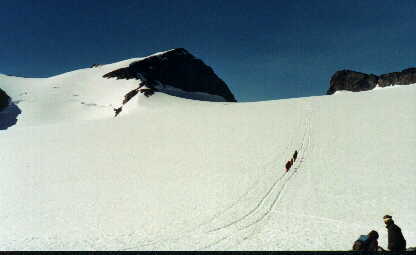
The following morning we arose and broke camp for an 8:40 AM bus departure for Juvashitta hut - a lodge which serves as the base for climbs up Galdh°ppigen. The narrow road had many hairpin turns which were handled in stride by the bus which had a remarkably small turn radius. Juvashitta also is the jumping off point for a ski run on an adjacent slope. We were above the treeline and, even at Juvashitta, had a commanding view of several peaks and valleys. It was a wonderfully warm and sunny day. We arrived at 10 AM.
It would be simple to ascend the 2,300 vertical feet up Galdh°ppigen, have a summit siesta, and return in time for the 4 PM bus departing for other points. As we approached the base of the glacier there were several hikers who were being roped up by guides for the crossing. According to a friend of Edward who had climbed Galdh°ppigen this precaution was unneeded, and so we had brought no rope. However according to a signpost at Juvashitta it was advised to use a rope due to possible hidden crevasses.
I have been trained to rope up on a glacier regardless of how safe it appears. I talked to the
guides and asked their opinion. They offered to take us on as just two more hikers for seventy
Norwegian kroner, about nine dollars, apiece. With such a bargain we roped up.

The number of paying hikers was enormous - I would say 100 or 150 total. There ended up being some thirty people per rope, a quantity that made for great safety yet sacrificed something in solitude. People walked in tennis shoes as well as hiking boots. There were elderly people and small children. Two dogs were roped, albeit via lieshes with their masters tied in to others. The pace up the glacier was very slow. Everyone proceeded across the glacier to a rocky outcropping some 500 feet below the summit.
At the rocks we unroped and were free to proceed to the summit at our own pace with a return of 2:30 PM to the rocks. Thirty minutes later Edward and I were at the summit along with dozens of swarming hikers. It was a relatively simple ascent. The summit views were spectacular. Alluring too was the herd on reindeer on the glacier. Why so far above grassy pasture?
After crossing the glacier en masse I paid the guide and
we proceeded to Juvashitta hut down a rocky trail in the company of a man
from Oslo who engaged us in conversation about traveling in Norway and the
United States. Due to the slowness of the collective group we returned too late for the bus.
That was OK - he drove us back to Löm in his private car and we exchanged addresses.
Another instance of exceptionally kind treatment had been dealt.
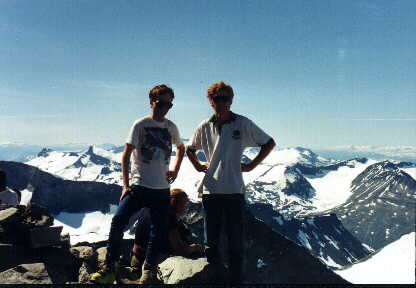
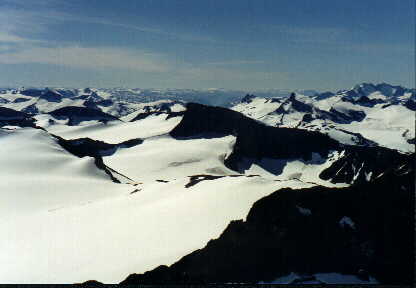
That evening we were free to explore Löm. For me the main attraction was a gourmet smorgasbord at a restaurant known for its traditional food. Among the many items were herring, salmon, and whitefish prepared several ways. The herring in a sweet mustard sauce was outstanding. Meanwhile Edward found a hot plate for camping use and opted for reheating a large tin of beans and franks we had purchased at Stat-Oil the previous day. We camped again.
I awoke around 5 AM and with the extra time explored one historic site in Löm,
a wooden stave church that dates back several hundred years. Edward had seen it the previous
evening while I was at the smorgasbord.
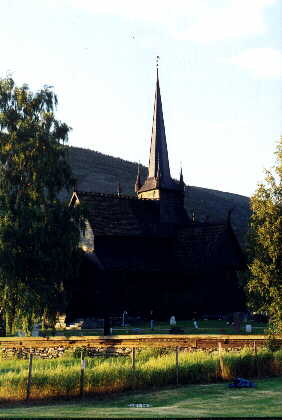
We again dragged our gear to the bus terminal and proceeded by bus through incomparably
beautiful mountain country to Sogndal - a town on the Sognefjord (the longest and
deepest in Europe) from which excursions are made within the fjord region. We learned from
the tourist office that a boat departs the harbor at 2:40 bound for Flåm.
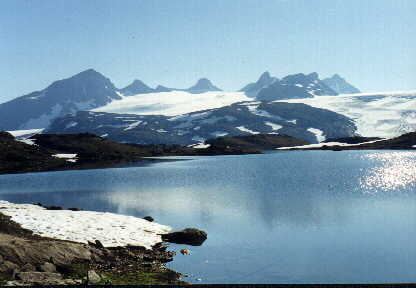
The journey to Flåm was on a speed boat, i.e., one designed for transport purposes and
not specifically for tourism. It traveled at perhaps 30 knots and we arrived in Flåm
around four. Flåm is a tourist trap.
I purchased and mailed a traditional Norwegian sweater to my mother just as she had
requested. We thanklessly hauled our stuff to a campsite located uphill
and across a bridge on the outskirts of town.
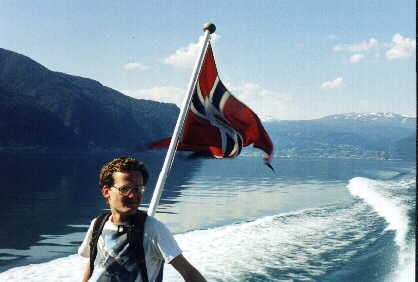
After supper in town we returned to our tent and engaged in conversation with an elderly couple from England who had devoted their lives to missionary work around the globe. They plied us with food and beverage to the point of complete satiety. In the morning the husband saw us off at the pier as we departed for a full day of cruising the fjords. The world could use many more such kind people.
We began the day with a round-trip cruise up the fjord with Flåm at its end, followed
by a sharp turn into the Næyerfjord ("narrow fjord") to Gudvangen. At that point we
reversed our route. The Næyerfjord is claimed by many as Norway's most
spectacular. At some points the mountains loom a full vertical mile above the waterway.
Noting their similar icy origins, it is akin to Yosemite Valley being filled with water.

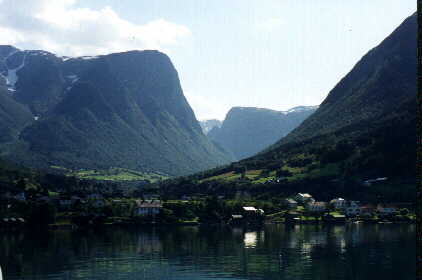
Upon return to Flåm mid-afternoon we spent a lazy hour waiting for the speed boat to Bergen. The boat sped down the Sognefjord to the seacoast, whence south amongst various waterways to Bergen. The five hour ride over about 8:20 PM, we were unceremoniously off-loaded with all our gear dockside in downtown Bergen.
Eventually we found ourselves at a cheap hostel for the night, sharing a quartet of bunks with an American headed to/from Saudia Arabia and a Japanese teen on vacation. Dinner, very late, had an international flair with curried banana pizza for me and a chicken pasta dish for Edward.
The following morning I visited the famous Torgat Fish Market on the Bergen wharf. Here
fresh and smoked fish plus seafood are available for immediate consumption at rock bottom
prices. Edward would not stomach the concept of smoked fish for breakfast (and I do not
blame him). I had a ball.
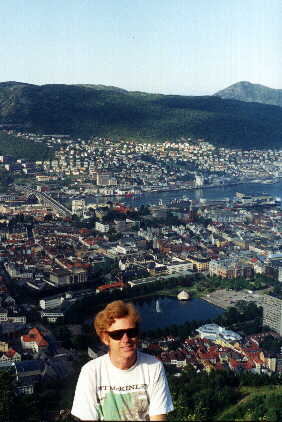
A steep tram lifted us up a thousand foot hill to a city overlook. After snapshots Edward hiked into the woods while I waited around admiring the view. I purchased a Norwegian tee-shirt and a pair of shot glasses with themes of Norway and Bergen. After Edward failed to return within an agreed time window I hiked down to the city and found myself at the hostel by noon. Evidently film trouble had delayed him. Edward appeared and we spent until 2 PM at the University museums of natural history and culture. It was a rewarding experience that most tourists appear to miss.
At 2:20 PM we were on an airport-bound bus for the flights to Amsterdam whence Geneva. I purchased in the duty-free store a bottle of Norwegian liqueur previously unknown to me. St.Hallvard Likor has strong herbal flavors and is extremely sweet.
We found Norway to be replete with beautiful scenery and courteous people. It was clean, well organized, almost crime-free and so ended up being the highlight of our vacation.
Following a near panic attack in the Amsterdam terminal wherein I spied chocolate delights of all manner yet without the time to effect purchase, we arrived in Geneva past sunset and took a train to the central Geneva station, Gare de Cornavin. Soon we were on a city bus headed in the wrong direction from our desired hostel. Eventually matters were straightened out and we slept cheaply yet soundly in the bunk room of an alternate establishment. Just prior to bedtime I had spent nearly an hour in Spanish discourse with a young lady from Mexico in the hostel kitchen.
The following morning bus #1 returned us to the Gare. So much for Geneva! We never intended to explore this city as it held nothing of interest to us.
Our immediate goal was Chamonix in the French Alps. The rail connection was via the Swiss town Martigny. With typical Swiss precision trains arrive and depart nearly to the second of the published times. However outside Switzerland punctuality is commonly violated, e.g., we experienced delays up to fifteen minutes at stations in Germany and Austria.
Connections on the European rail network are synchronized with typically six to eight minutes between the arrival of one train and departure of the next. This is sufficient provided you are either a native OR you understand exactly where in the station the departing train is located, AND you are fleet of foot. With multiple pieces of luggage at a large terminal, e.g., Munich, a connection could easily be missed. We found it best to stand at the exit door even as our inbound train was decelerating, so ensuring our timely exit before the train shut its doors and accelerated towards the next station. It could be quite close.
The train from Martigny was designed with high grades in mind. We crossed into
France amidst little fanfare and much mountain scenery.
By 1 PM we arrived at the tourist and extreme sport mecca of Chamonix. The immense
white massif of Mt.Blanc was immediately at hand on the south side of the valley.
Rocky spires and pinnacles were everywhere on the southern skyline, including the
Aiguille du Midi with a cable car leading to its summit some nine thousand feet above
Chamonix. To the north verdant mountains of a mellower note sported several para-gliders
thousands of feet above the valley floor. Chamonix was amidst a
mountain wonderland!
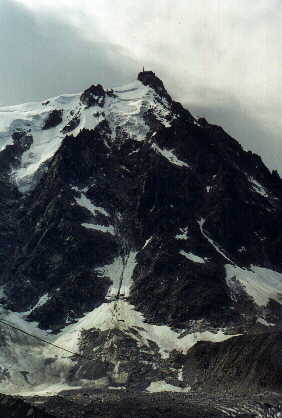
As we took turns guarding our mountain of gear at the gare (train terminal in French), several errands were accomplished - the purchase of several hundred Francs; fuel for cooking; a new water bottle for Edward (to replace one that had inexplicably cracked upon being dropped from arm level); and stowing items not essential to climbing with a luggage concierge at the gare.
At the gare the majority of travelers had backpacks and even climbing equipment. For the first time at a public terminal we looked the same as everyone else! Most were young people in their teens or twenties, and they spoke every major language (I even talked in Hebrew to some Israeli hikers). It was ironic that such an outdoors-oriented venue could be so cosmopolitan as well.
The normal route up Mt.Blanc includes two high altitude huts for lodging. A mountain office informed us that the upper, Gouter hut was fully reserved. This was very disappointing since it meant that we could not use it as a staging point. Any ascent would have to be in one big push from the lower, Tete Russe hut. We reserved space for the Tete Russe on the following night.
With our backpacks we boarded a train for the brief journey to St.Gervais / Le Fayet, a group of connected towns which form the low altitude terminus of a cog railway that leads, as its upper terminus, to the base of Mt.Blanc. Evening saw us at a campsite some 2 kilometers out of town. The higher slopes of Mt.Blanc were hidden in cloud and a light rain made life less than comfortable.
The following morning we walked into town and, after a final ice cream cone,
wended our way through the forest by cog railway to Nid de Aigle,
the railway's highpoint at some 7,600 feet.
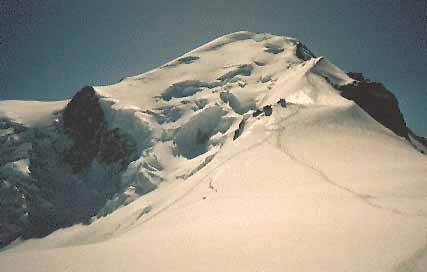
We assumed climbing up a rocky but well marked trail and, after some four or five hundred vertical feet, paused to cache our tent and extra food in the nearby boulders when no one saw. It was "illegal" to camp outside of the huts and so the tent was superfluous. Furthermore since meals were available for purchase at the huts, Edward left behind some food.
We clambered up the serpentine trail, essentially unacclimated, as the ridge leading to the Tete Rousse hut at 10,400 feet. The hut was nearly empty but for a staff of three and arriving climbers. Climbers interested in the Gouter hut were assigned to the room with a 7 AM wakeup. Those interested in the summit were in another room with a 1 AM wakeup. We chose the latter even though I personally felt that a summit attempt with just 12 hours acclimatization was futile.
After a shot of cognac I conversed,
in slow English and broken Russian, with a Polish couple
eyes set on the summit. A Japanese couple made for an international atmosphere.
They had climbed Mt.Fujiyama yet had little experience that was relevant to
an ascent of Mt.Blanc. Later I secured a group photograph outside the hut.
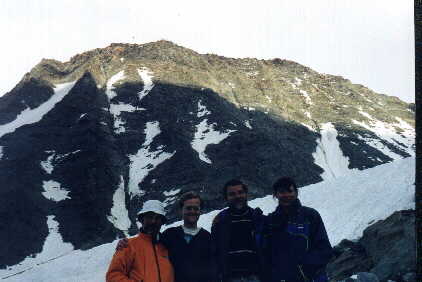
I paid the 95 francs each for the night. Edward and I opted to eat our own food at dinnertime.
At 1 AM Edward awoke only to find the wind biting hard and he returned very shortly.
In the morning we learned of an official weather report that called for 70 k.p.h. winds, increasing to 100 k.p.h. the following day. I also learned that the cable ride to Aiguille du Midi had been shut down due to high winds. We also heard firsthand that spaces were available at the Gouter hut from climbers who had abandoned their efforts due to poor conditions.
Under these circumstances Edward and I differed as to whether it was worth continuing. Edward argued correctly that we had nothing to lose by continuing to the Gouter hut, and we would learn about the route for some future time when mother nature would be kinder. However for me there WAS something to be lost: two days in town enjoying the best cuisine France could muster. Guaranteed.
Was it preferable to hope for a break in the weather and get a shot at Mt.Blanc, or take the sure thing? I estimated the probability of a successful climb at 15%. My personal valuation was that the reward of enjoying French food for two days exceeded the quantity (0.15 x reward of climbing Mt.Blanc). For Edward the lure of gourmet food was almost nonexistent.
Thus by midday Edward struck out for the Gouter hut while I descended to Nid de Aigle. Some might call my decision a rationalization of having whimped out. I felt that, given the information available, it was the prudent choice. I wished Edward well yet told him that Gouter would likely be as far as he'd get. We arranged that I call the Tete Rousse hut to inform him, on descent, of my whereabouts.
After an uneventful descent and rail journey I took a room in Le Fayet. Dinner centered on cheese fondue with a carafe of white wine and was followed by a pair of desserts.
In the morning I called the Tete Rousse hut according to plan, and learned the weather was mauvais, i.e., bad. I then phoned the Gouter hut and learned that it was impossible to climb. I thus anticipated Edward to return sometime that day. I lounged in my room with the occasional trip to the patisserie (bakery) for assorted edibles.
Edward returned mid-afternoon and, with the climbing portion of the trip concluded, contemplated how the following day, allocated for inclement weather, might be spent as "tourists". We had dinner at the same brasserie as the previous night. Edward had tagliatelle carbonara (essentially noodles in a creamy cheese and egg sauce with bacon). I enjoyed the 186 Franc prix fixe menu, including esgargots in a roquefort cream sauce as appetizer, and perfectly cooked game bird with accoutrements for the main course. There followed a cheese course and dessert.
In the morning we checked out and I appended to the bill 60 Fr. as the price of six ice cream bars I ate in the middle of the night from an unlocked freezer in the hotel lobby. At virtually every shop in our travels one found such a freezer filled with ice cream novelties of assorted flavors. I particularly enjoyed the pistachio with chocolate and the coffee almond crunch. Whenever our railway layover exceeded 15 minutes I would grab one and get on the next train (the standard six to eight minute connection was insufficient).
A major tourist attraction is the cable car from Chamonix via an intermediate station to the top of Aiguille du Midi at 12,600 feet elevation. From there one may take a second car and ride horizontally over the glaciated terrain of the French Alps to an analogous Heilbronner terminal situated at high altitude on the Italian side of the range. A third car descends to an Italian town. Return is normally via the Mt.Blanc tunnel which, as the name suggests, bores straight through the Mt.Blanc massif and directly connects Italy with France.
The Mt.Blanc tunnel suffered an explosion in March. A long bus ride provided the return to Chamonix during our vacation. Since the weather at high altitude was marginal even for viewing purposes, given the duration of the bus trip we decided to simply ascend the tram to Aiguille du Midi and return directly to Chamonix.
As we boarded the cable car under sardine can-like conditions, we were instructed
to leave behind our ice axes for safety reasons. A ten minute ascent transformed
calm and sunny conditions to near freezing with wind gusts that caught most tourists
off guard. Welcome to the world of high mountains!
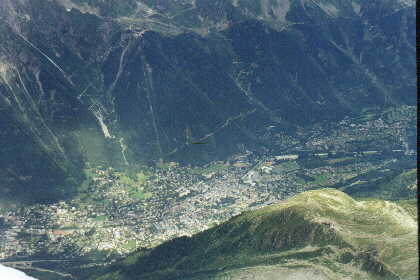
The views were awesome. We were suddenly at the same elevation as the Gouter hut for but the effort of dispensing some 200 Fr. apiece (some $36). It was evident that Mt.Blanc could be climbed from our location by a route only slightly more technical than the standard route we had attempted. After perhaps an hour occupied by several snapshots and a large, delectable apricot-studded cheesecake slice I shared with Edward, we left this beautiful, icy world for more hospitable conditions far below.
In the afternoon we took a cog train to Mer de Glace - a large glacier (by Alps
standards, at least) with an artificial ice cave carved out for tourists to pass.
Each year as the glacier moves down valley a new cave is produced so that its entrance
roughly coincides with the train terminus. A short cable car ride takes one down the
several hundred feet from the terminus to a 200 foot high series of concrete steps
that lead to the cave entrance.
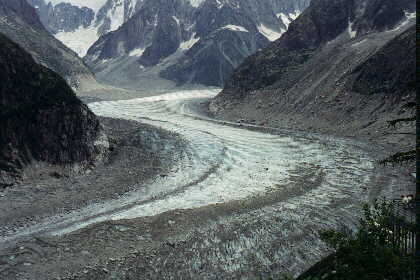
The ice posessed a blue tint characteristic of dense glacial ice under certain
lighting conditions. Essentially a tunnel with circular cross-section of maybe ten
or twelve feet diameter, the cave was filled with ice statues of various familiar
objects such as a bear; a bed; and a "kitchen" with stove and stovepipe. It was
in my view somewhat quaint and a little silly. The internal air temperature
was 5 Celsius (41 F), so that the very dense walls were slighly moist to the touch
from a thin layer of meltwater.
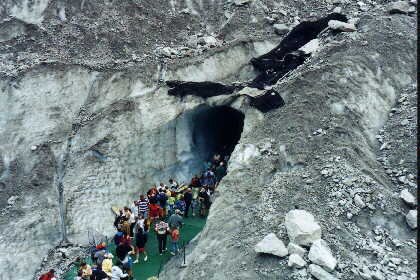
We returned to Chamonix and found a camping site within walking distance of town center. I was tempted to have dinner at a nearby restaurant yet prices were somewhat prohibitive. Edward and I opted for a market instead. At camp my paté and French bread were washed down with a bottle of sweet cassis liqueur. I'm happy.
It was now Tuesday the 10th. The total solar eclipse was due midday Wednesday. The original plan was train travel to Salzburg, Austria for observation. Instead we decided to view from or just outside Munich, Germany. The rail system had lines more or less paralleling the eclipse track near Munich, i.e., east by southeast and west by northwest. The lines near Salzburg were oriented more north and south. Thus should a pattern in the cloud cover suggest better weather conditions elsewhere, we would be able to board a train and head there within an hour.
The route to Munich included passage through Zurich. Prior
to Zurich was a one or two hour layover in Martigny.
Edward took the time to dry out the tent in a high wind while I enjoyed assorted
Swiss chocolates with the ever-available ice cream cones.
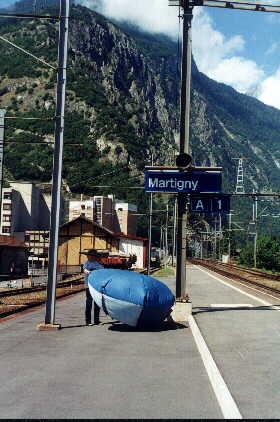
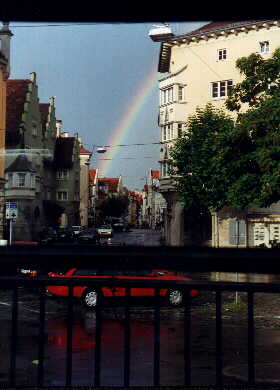
We arrived in the Munich terminal just before nine PM and surmised that camping would be easier to find just outside this major city. Thus we traveled by rail east by northeast some 20-30 kilometers to a small town that was nearly dead center on the middle of the eclipse track (so giving us maximum duration of the total phase).
There was no official campsite. To avoid rousing suspicion we did not pitch a tent, sleeping under the stars in an abandoned parking lot near the railway station.
I was awake by 4 AM examining cloud patterns. By dawn around 5-5:30 AM it was evident that the clear sky of night was progressively worsening. The entire morning was spent pacing back-and-forth, worrying about mounting cloud cover. There was nothing to be done - sky conditions appeared just as bad in any direction. Hence there was no point in moving.
Our GPS (global positioning satellite) receiver pinpointed the latitude and longitude. Using this data, Edward calculated the exact times of second and third contact, i.e., the total phase's start and end. I then checked the sanity of his calculations which predicted these moments with one second accuracy.
The partial phases would last for nearly 1 1/2 hours before and after totality. The sky was filled with cumulus heading south or southeast.
The partial phase prior to totality was visible at times in-between passing clouds. A mylar film allowed for safe viewing. A progressive darkening of surroundings was evident some half hour before totality. For a few moments the sun was directly visible during "deep" partiality about ten minutes before totality. Then once again hidden by cloud.
As if to add insult to injury, it began to sprinkle eight minutes before totality. It appeared quite hopeless. A total solar eclipse far outperforms any partial eclipse, including, of course, the partial phases thereof. Edward had successfully observed three total solar eclipses while I had seen one (Bolivia, Nov.3 1994). So we knew what to expect.
The moon's shadow raced across the land and created interesting patterns of light and dark on the cloud tops. Our principal indication of totality was the sudden deep twilight. Light-sensitive street lights automatically illuminated. Headlights of a train at the rail terminal turned on while it sat motionless as if in respect. The sun was completely obscured by cloud.
After totality the southeast sky remained dark as the moon's shadow raced onwards. It would eventually pass over Eastern Europe, Turkey, and loose earth contact at India. We consolidated our gear and hopped on a 1 PM train for Munich thence south.
Tyrolia, or Tirol, is a mountainous region in western Austria well known for hiking
and skiing. We passed through Tirol all too briefly on our rail journey out of Germany
and bound for the Matterhorn. Innsbruck is the chief city in Tirol, albeit dwarfed
by Salzburg and Vienna. The scenery was idyllic. Mountains, although impressive, left
not the Himalayan-like imprint of the French Alps. It looked more like Colorado and
less like a polar ice cap.
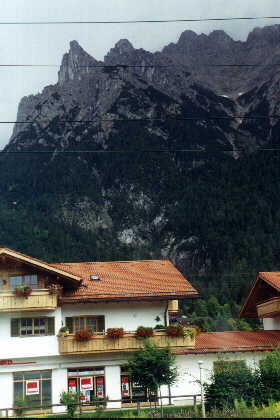
We were forced to make a bus transfer and camped in the rain and mud near Bludenz, a city west of Innsbruck. It had been an alltogether disappointing day with the failed eclipse.
Our brief experience in German-speaking Europe deserves additional comment. In contrast to Switzerland and France with multiple translations in both text and public announcement, only German was used on the Austrian and German portions of our railway journey. Furthermore I found the shopkeepers and train personnel (i.e., the people we dealt with) as less friendly and less open to us than elsewhere. Edward received similar impressions. I was pleased to be re-entering Switzerland, and in particular, the French-speaking portion thereof.
The following morning we continued by rail to Zurich whence south to Zermatt for views of the Matterhorn. A second mandatory tranfer to a bus was made. As we showed our passports at the Swiss border we did not realize at the time that we actually were entering Liechtenstein. This small country of some 160 square kilometers is home to some 30,000 people with the capital at Vaduz. It speaks German and aligns itself politically with Switzerland.
The rail line to Zermatt is privately owned and operated. So we suspected that our Eurosaver passes would not cover this section of our travel. However we were assured by a Swiss passenger desirous of English practice that this was not a concern.
How wrong she was! After boarding the private line at Brigg the conductor walked by and examined our passes. He was due 76 Swiss Francs apiece and insisted that payment be made immediately or by obtaining cash at the first stop, Visp. We had insufficient Swiss currency so at Visp Edward exchanged dollars for a pair of round trip tickets.
We arrived at Zermatt in poor weather around 5 PM. No significant scenery was visible. In the rain we walked with all our luggage across town, looking like fools, to a hostel which we found completely full. Somewhat fed up with matters I suggested that we just return by train to Brigg and spend the night there. Edward wanted to camp even though it was raining and we had alternatives. I hailed a taxi who brought us to a campsite near the rail station. It stopped raining and we pitched the tent.
That evening Edward had spaghetti at some cafe while I sat down at a restaurant specializing in Swiss/German cuisine. Hot wine soup was a wonderful first course. It was more creamy than wine-like. The entree was deer steak in a very slighly sweet yet piquant peppercorn sauce. Accompanied by spaetzle and spinach. Edward was kind enough to meet me and ordered a spectacular hot apple fritter dessert with vanilla sauce. Walnut ice cream with plums, whipped cream and an inordinate amount of slivovitz (plum brandy) had me asking if they served it to children.
Edward and I returned to camp whence he cooked for himself Ramen noodles. He
was concerned that he had lost weight on the trip and wished to eat more. I had
little trouble finding appetizing food. Indeed, my mean caloric consumption
was about 4,500 calories daily, roughly double what it should normally be.
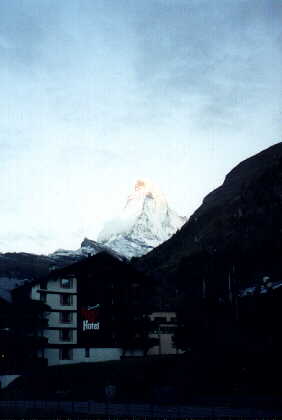
Luck was with us at 6:30 AM. The Matterhorn was plainly visible in the pink hue of early sunrise. As we walked in town west to avoid a nearby ridge for an unhindered view, many Japanese tourists were scurrying about, exiting their posh hotel rooms in the morning chill, for a one-time glimpse of this awesome sight. The light turned brilliant white on the mountain's eastern face, yet within an hour the weather had turned.
I attended a chocolate shop for a small box of truffles and a prune pastry. We departed on the next train after eight with the goal of Paris by nightfall.
The key waypoint for taking the French bullet train was Lausanne, located, as is Geneva, on Lake Geneva. After a string of connections we boarded the TGV around 1 PM for a 4 1/2 hour ride to Paris.
Given the Lausanne-Paris distance and the speed of a bullet train it should not take so long. The conductor informed us that the high-speed portion was restricted to the section from Dijon to Paris. Within that segment of perhaps 150 or 200 kilometers, our watch and road markers allowed one to compute a speed corresponding to five kilometers in 68 seconds, i.e., some 164 miles per hour. This was roughly as fast as the takeoff speed of a jet airliner. The nearby terrain rushed by with the same sensation of speed as a jet poised to lift off a runway.
The sensation of speed was momentarily heightened further when another train passed by in the opposite direction just feet from my window. Slight variations in speed were noted with changes in the grade. For most of the high-speed run we traveled in-between 130 and 150 MPH. We arrived at Gare de Lyon on schedule.
Accomodations in Paris was a nightmare. After a half hour wait in a line for taxis, we spent 85 Francs for a 2 mile ride to a hopeful hostel. We were refused service due to a 30 year age limit. I guarded our mound of luggage while Edward walked about, guidebook in hand, searching for a hotel on foot.
Nothing turned up. I had the hostel's front desk call around and we made reservations at one Hotel Moderne to which we walked, again like fools, amidst the street cafes to said establishment. The desk did not have our reservation! Evidently there are three hotels in Paris by that name and we had walked to the wrong one. However they had a single room with one bed for 200 Francs a night - cheaper than the hostel.
You knew you were not in a prison only because a key was available. I did not care any more and would sleep on the floor. The toilet was down the staircase (there was no hallway), and a shower would be extra.
I bought artisanal quality (i.e., not mass-produced) cheese and a boule of
walnut bread from a fromagerie (cheese shop). Edward went to a Chinese restaurant
for brocolli beef while I heated up a vacuum-sealed Swiss-style meal in
the room, a shredded potato dish known as rosti, with care to place the burner near our
open window for ventilation. I was too disgusted with our hotel search to
eat out.
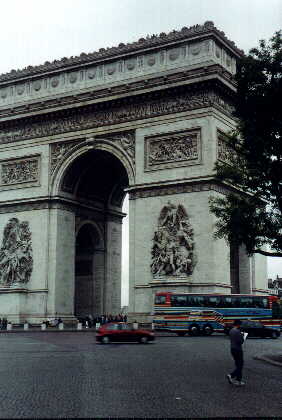
A patisserie provided our breakfast as we walked into Le Metro for the subway ride to the Arc de Triomphe. I had never seen a radially-arranged street pattern on such a grand scale. To access the monument on foot you travel through underground passages beneath the circular street.
After a brief stop at the tourist information office we walked the two
kilometers to the Eiffel tower. An electronic sign halfway up the tower
enumerated the number of days remaining until the new millennium.
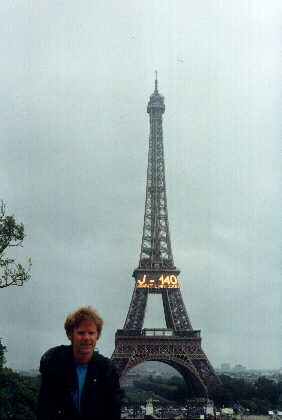
We purchased tickets to ascend the tower on foot. One may do this only to the second level, about halfway up, whence the tower becomes too narrow to admit of both a passenger elevator and stairwell. At that point the waiting queue for the top was too lengthy in my view to merit the effort. I purchased a glass Eiffel tower containing sands of assorted cool pastel colors as souvenir and descended.
Somehow we had lost one another. I waited at a designated park bench about
an hour, in the rain, only to give up waiting for Edward who I presumed had
decided to stand in line.
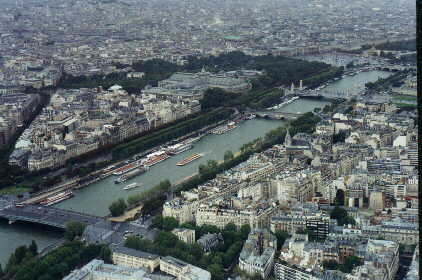
Edward had indeed been to the top, and, as I learned later, had briefly visited Notre Dame cathedral. I had different plans. After miracoulously returning to our hotel room with neither map nor guide book, I purchased several French pastries and a liter of Italian gelato for my afternoon's entertainment. The ice cream was half each vanilla and chocolate with a ribbon of cherry jam at the vanilla/chocolate interfaces.
The evening centered on dinner at an Italian restaurant which had pizza Margherita for Edward (i.e., the tomato and cheese variety). I began with an eggplant "caviar" appetizer and crusty French bread. My plat principal was pasta a la Greque, i.e., spaghettini with olive oil and lardons. The latter was enhanced by parmigiano reggiano and reserved eggplant. I did not enjoy my first experience with grappa, a liqueur, as it was neither sweet nor had any particular flavor. Dessert was griselles with ice cream and cookies. Evidently griselles are berries which are then steeped in kirsch.
Upon checkout we planned on a taxi to Gare de Lyon whence a bus service to Charles de Gaulle airport. The taxi driver offered to undercut the bus fare and upon our consent drove us directly to the airport. Sometimes things do work out.
After checking our baggage we proceeded to our gate nearly three hours early. The gate area is bereft of stores save a single concession selling drinks and ice cream. I backtrack past the x-ray inspection point and am confronted by a bewildering array of duty-free shops. Unlike Amsterdam I now have both time and money. I call my mother who instructs me to purchase her this-and-that perfume and lipstick. I acquire truffle oil and, in yet a third shop, spy a bottle of Remy Martin King Louis XIII cognac for 12,890 Francs - some $2,200 dollars! I had no intention to purchase, of course.
Our flight to Detroit was delayed one hour and so we missed our connection to San Diego. We rebooked for a flight five hours later and spent the time walking aimlessly through Detroit's terminal building. A food voucher good for two seven dollar meals was provided by Northwest. Unfortunately we were constrained to eat at the same establishment for it to be of value. Edward and I could not agree on where to use it - I found a $7 appetizer at a swank restaurant while he wanted Little Caeser's.
I decided it was not worth arguing about - pizzeria it would be. Edward ordered (and ate) everything he could until the $14 limit was reached. I nibbled at his spaghetti and lasagna and wished I were back in some country where people understood and appreciated fine cuisine. Fortunately I was not hungry - and had not been so the entire trip. It was strange to never be hungry for two weeks. My Greek salad was not to my standard what with iceberg lettuce (i.e., no romaine or radicchio), no olives or anchovies, and but a sprinkling of feta cheese.
The flight to San Diego was unremarkable. So I won't remark.
Inclement weather effectively hurt the two most important goals of our vacation, as Mt.Blanc and the total eclipse. As these misfortunes are beyond our control I can accept them. We have both seen previous total solar eclipses and have both successfully climbed mountains of similar stature, if not greater still.
The vacation was overall a successful adventure into a culturally rich and historical part of our world. I am pleased with its outcome. Yet happy to be home.